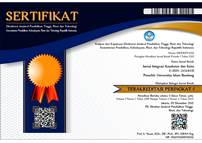Perubahan Mikrostruktur Jaringan Hati pada Mencit Model Sindrom Metabolik yang Diberi Fraksi Zingiber officinale
Abstract
Non-alcoholic fatty liver disease (NAFLD) merupakan penyakit perlemakan pada hati yang terjadi pada penderita sindrom metabolik. Penderita sindrom metabolik terjadi peningkatan kadar stres oksidatif sehingga muncul sel steatosis dan pelebaran sinusoid hati. Senyawa flavonoid dalam Zingiber officinale (jahe gajah) diketahui memiliki efek hepatoprotektif dan antiinflamasi dengan cara menghambat pembentukan reactive oxygen species (ROS). Tujuan penelitian ini mengetahui pengaruh fraksi etil asetat jahe gajah terhadap mikrostruktur jaringan hati pada mencit model sindrom metabolik. Objek penelitian ini menggunakan mencit jantan galur Swiss Webster yang berusia 36−40 minggu dibagi menjadi 4 kelompok. Penelitian dilakukan di Laboratorium Farmasi Institut Teknologi Bandung. Kelompok kontrol yang diberi pakan tinggi lemak tanpa diberikan terapi selama 28 hari. Kelompok II−IV diberi pakan tinggi lemak dan diterapi dengan diberi fraksi etil asetat jahe gajah dengan konsentrasi 0,78 mg, 1,56 mg, dan 3,12 mg per kilogram bobot per hari diberikan secara oral. Observasi dan kuantifikasi mikrostruktur jaringan hati dilakukan menggunakan mikroskop cahaya. Hasil statistik jumlah sel steatosis belum menunjukkan hasil yang signifikan (p>0,05), sedangkan pada jumlah pelebaran sinusoid menunjukkan hasil yang signifikan (p<0,05). Kekuatan korelasi konsentrasi fraksi jahe gajah dengan jumlah sel steatosis rendah, tetapi pasti (r=-0,381) dan pelebaran sinusoid cukup berarti (r=-0,451). Simpulan penelitian ini adalah pemberian fraksi etil asetat jahe gajah memengaruhi mikrostruktur jaringan hati pada mencit model sindrom metabolik.
LIVER TISSUE MORPHOLOGICAL CHANGES BY ZINGIBER OFFICINALE FRACTIONS IN METABOLIC SYNDROME MICE MODELS
Non-alcoholic fatty liver disease (NAFLD) is a fatty liver disease that occurs in patients with metabolic syndrome. Patients with metabolic syndrome occur closer to oxidative stress that occurs in steatosis and dilation of the liver sinusoid. Flavonoid compounds in Zingiber officinale have hepatoprotective and anti inflammatory effects by inhibiting the formation of reactive oxygen species (ROS). The purpose of this study was to determine the content of Zingiber officinale ethyl acetate fraction on liver tissue microstructure in mice model of metabolic syndrome. This research method using mice of Swiss webster strain which had 36−40 weeks, divided into 4 groups. The study conducted at Pharmacology Laboratory Institut Teknologi Bandung. Control group fed high fat without therapy for 28 days. Group II−IV were fed high fat and treated with ginger elephant ethyl acetate fraction with a concentration of 0.78 mg, 1.56 mg and 3.12 mg per kilograms of body weight per day, given orally. Observation and quantification of liver tissue microstructure was performed using a light microscope. The statistical results on steatosis cell counts did not show significant results (p>0.05), whereas the number of sinusoid enlargement showed significant results (p<0.05). Alternative strength of the Zingiber officinale fraction with a low but definite steatosis cell number (r=−0.381) and significant sinusoid widening (r=−0.451). In conclusion, that administration of ginger elephant ethyl acetate fraction affected microstructure of liver tissue in mice model of metabolic syndrome.
Keywords
Full Text:
PDFReferences
Adiwinata R, Kristanto A, Christianty F, Richard T, Edbert D. Tatalaksana terkini perlemakan hati non alkoholik. JPDI. 2015;2(1):53 ̶ 9.
Dyson JK, Anstee QM, McPherson S. Non-alcoholic fatty liver disease: a practical approach to treatment. Frontline Gastroenterol. 2014 Oct;5(4):277–86.
Halegoua-De Marzio DL, Fenkel JM. Concepts and treatmet approaches in nonalcoholic fatty liver disease: Advances Hepatol. 2014:1–7. (diunduh 20 Agustus 2018). Tersedia dari: https://www.hindawi.com/journals/ahe/2014/357965/.
Kumar V, Abbas AK, Fausto N, Aster J. Robbins & Cotran pathologic basis of disease. Edisi ke-8. Philadelphia: Saunders; 2010.
Chalasani N, Youbossi Z, Lavine JE, Diehl AM, Brunt EM, Cusi K, dkk. The diagnosis and managemen of non-alcoholic fatty liver disease: pactice guideline by the American Assosiation or the Study of Liver Disease, American Collage of Gastroenterology, and the American Gastroenterological Assosiation. Hepatology. 2012;55(6):2005–23.
Tzeng TF, Liou SS, Chang CJ, Liu IM. 6-gingerol protects against nutritional Steatohepatitis by regulating key genes related to inflammation and lipid metabolism. Nutrients. 2015;7(2):999–1020.
Author C, Sikkim E, Authors C. Pharmacognosy Zingiber officinale: a natural gold. Int J Pharma Bio Sci. 2011;2(1):283–94.
Yulianti AB, Widayanti, Rahmawati I. Efek proteksi campuran ekstrak bawang putih, jahe gajah, dan lemon terhadap kadar kolesterol total darah pada mencit tua yang terpapar diet tinggi lemak. Prosiding SNaPP2017 Kesehatan. 2017;3(1):215–21.
Motawi TK, Hamed MA, Shabana MH, Hashem RM, Abdul AFN. Zingiber officinale acts as a nutraceutical agent against liver fibrosis. Nutr Metabolism (Lond). 2011;8:40. doi:10.1186/1743-7075-8-40.
Loho IM, Hasan I. Drug-induced liver injury - tantangan dalam diagnosis. CDK. 2014;41(3):167–70.
Al-Katib SM, Al-Khashab EM, Kalo MS, Hamdoon AA. The antioxidant effects of flavonoids and non flavonoid part extracted from Ginger (Zingiber officinale) roots. Jou Raf Sci. 2009;20(3):18–31.
DOI: https://doi.org/10.29313/jiks.v1i1.4316
Refbacks
- There are currently no refbacks.
Jurnal Integrasi Kesehatan dan Sains is licensed under a Creative Commons Attribution-NonCommercial-ShareAlike 4.0 International License.







.png)
_(1).png)




















